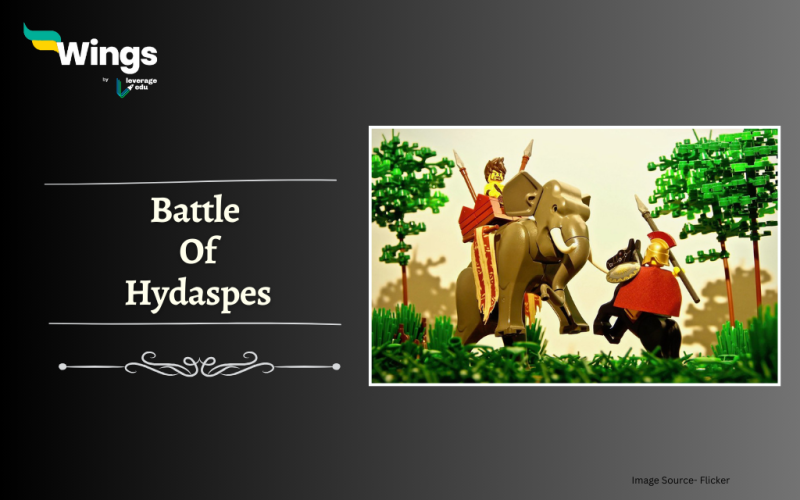In ancient history, the Battle of Hydaspes was a military engagement that took place between Alexander the Great and King Porus of Paurava in 326 BC. This epic battle occurred near the Jhelum River, which was known as the Hydaspes River in ancient times. Despite facing fierce resistance from Porus’ army, Alexander’s force managed to break through the enemy lines and surround Porus and his troops. In a bold last stand, Porus fought bravely against overwhelming odds but was eventually captured by Alexander. However, impressed by Porus’ courage and honour, Alexander spared his life and even appointed him as a satrap in his empire. Let us know more about this Battle of Hydaspes in detail.
Table of Contents
| Battle of Hydaspes Overview | |
| Battle Took Place In | 326 BC |
| Place | Near Jhelum River |
| Fough Between | Alexander Vs King Porus |
| Won By | Alexander, The Great |
Background Of The Battle
After Alexander’s victory against the Achaemenid Empire’s forces in 328 BC, he planned to expand his empire towards India.
- In 327 BC, he started his Indian campaign by fortifying Bacteria with 10,000 soldiers and invaded India through the Khyber Pass.
- Despite having a much larger army, Alexander suffered huge losses during the Battle of Hydaspes, where an estimated 40,000 infantry and 5,000 cavalry engaged the enemy.
- Alexander led a smaller force through the northern route and conquered the fortress of Aornos, a place which was of mythological significance to the Greeks.
- Later, Alexander formed an alliance with Taxiles, the King of Taxila, to fight against King Porus of Hydaspes, who refused to surrender to Alexander and was preparing for war.
Also Read – Kalinga War Notes: Origin, Causes and Significance
People Involved In The Battle
- Alexander the Great: Alexander the Great, also known as Alexander III of Macedon, was one of the greatest military commanders in history. He was the king of the ancient Greek kingdom of Macedon and created one of the largest empires of the ancient world. Alexander’s conquests extended from Greece to Egypt, Persia, and parts of India.
- King Porus: King Porus was a powerful ruler of the kingdom of Paurava, located in the Punjab region of the Indian subcontinent. He was known for his bravery and valour in battle and his kingdom was strategically located along the banks of the Hydaspes River, making it a key territory in Alexander’s campaign.
- The Hydaspes River: The Hydaspes River, now known as the Jhelum River, was a major waterway in ancient times. It provided a natural barrier between the kingdoms of Alexander and Porus, with Porus stationed on the eastern bank and Alexander on the western bank.

Events of the Battle
Alexander established his camp near the town of Jhelum, to the right of the river. Afterward, in the spring of 326 BC, Porus positioned himself on the southern bank of the Jhelum River to prevent any attempts at crossing. The Jhelum River was too deep and swift, making it almost impossible for any army to cross safely.
- At last, the two armies met and positioned themselves for the impending battle. The Indian army placed cavalry on both flanks, with their chariots in front.
- Meanwhile, the centre of their army consisted of infantry positioned every fifty feet, along with war elephants to deter the cavalry of Macedonia.
- The war elephants used in India were equipped with heavy armour and had howdahs placed on their backs. These howdahs could hold up to three archers and javelin men.
- The Pauravan soldiers wore brightly coloured outfits and steel helmets and carried lances, axes and maces.
- Unlike other Indian kings, Porus chose not to fight from a chariot and instead rode on top of his tallest war elephant. The king’s elephant was not facilitated with a howdah, as Porus wore chainmail armour and did not require additional protection.
Also Read – Battle of Plassey: History, Context, and Legacy
Alexander observed that Porus had stationed his strongest troops in the centre, so he devised a plan to attack with his cavalry on the flanks first. The Macedonian phalanx, which consisted of heavily armed infantry, would hold back until the Indian cavalry had been neutralized. Although the Indian infantry outnumbered the Macedonian phalanx by 5 to 1, they were at a huge disadvantage in close combat because of their lack of armourial facilities and the long reach of the Macedonian sarissas. Additionally, the slippery ground made their heavy armour-piercing bows inaccurate, although the muddy terrain was an advantage for the lighter-armoured Indians.
- The Macedonian cavalry faced the war elephants, while the Macedonian phalanx stood in their way.
- The powerful elephants caused significant casualties among the Macedonian infantry soldiers, piercing several men with their steel-clad tusks.
- The elephants lifted some soldiers into thin air before crushing them.
Despite this, the Macedonian infantry fought back courageously. The light infantry hurled javelins at the elephants’ mahouts and eyes and the heavy infantry tried to incapacitate the elephants with two-sided axes.
Credits – eventsmauritius.travel
Outcome Of The Battle
Eventually, the Macedonian soldiers advanced with locked shields and their cavalry charged from the rear to create a “hammer and anvil” effect, causing the Paurava army to flee. The Battle of the Hydaspes concluded with a huge victory for Alexander the Great, once again solidifying his reputation as one of history’s greatest conquerors.
Relevant Blogs
This was all about the Battle of Hydaspes. For more content related to the different states of India, visit our articles like this, you can get Study notes on the Modern History of India here. Also, you can visit our general knowledge page on Indian History!
 One app for all your study abroad needs
One app for all your study abroad needs













